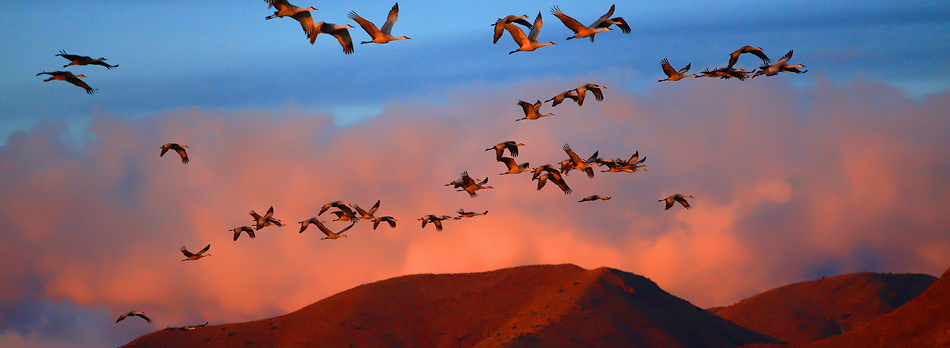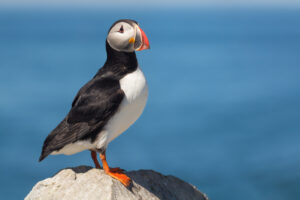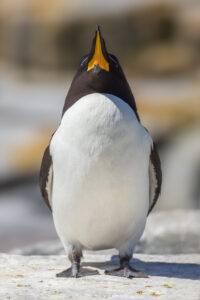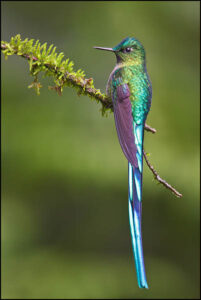Growing up, I was always captivated by nature and the incredible places on this planet. I have been fortunate enough to visit many of these amazing places. However, it seems like there is a never-ending list of locations that I still dream about visiting. Three of these places are Bosque del Apache National Wildlife Refuge (NWR) in New Mexico, Machias Seal Island in the Bay of Fundy, and the Tandayapa Bird Lodge in Ecuador.
Bosque del Apache National Wildlife Refuge
Bosque del Apache NWR is a preserve containing a lot of marsh habitat along the Rio Grande in San Antonio, New Mexico. The thing that makes this area special is the immense number of Sandhill Cranes that congregate in these marshes over the winter. The cranes generally start arriving at the refuge in October and stay through February. They utilize the marsh habitat to roost overnight and then spend the days feeding in the nearby fields. At times, these birds can be found by the thousands within the refuge!

Sandhill Cranes tackle an impressive migration each year. Many of the individuals found in Bosque del Apache NWR in the winter likely spent their summer in either Alaska, Canada, or Siberia. This long migration means that these cranes have to fly across parts of the Rocky Mountains. It’s hard for me to imagine what these birds may experience as they travel such long distances over harsh terrain and through unforgiving conditions. During this migration, they are often found in small groups, so it would be quite a spectacle to see thousands of these birds all together in the refuge. Bosque del Apache NWR provides a crucial resting spot for them to regain energy before starting their migration again.
Machias Seal Island
Machias Seal Island is a rocky island located in the Bay of Fundy off the coast of northern Maine. There is some debate about who owns the island as both Canada and the US claim ownership of it. Either way, this small island provides nesting habitat for multiple pelagic bird species including Atlantic Puffins, Razorbills, and Common Murres. In the early summer, these birds congregate on the island in the hundreds or thousands to breed and raise their young.


This island is very important for the preservation of these species as climate change is continually driving them north and reducing the quantity of viable nesting habitat for them. These birds rely on cold ocean water to provide the food they need, but climate change is making the range of the fish they feed on smaller.
I had the opportunity to visit Machias Seal Island in the summer of 2016 and it was one of the most memorable birding experiences I have ever had. I got to spend two hours in a blind as these birds moved all around me. I could even listen to them walking on the top of the blind! Even though I have already been to this location, the beauty of the animals and the uniqueness of getting to see so many at such a close distance draws me to go back.
Tandayapa Bird Lodge
Tandayapa Bird Lodge is located in the Andean Cloudforest near Quito, Ecuador. Ecuador is one of the most biodiverse countries in the world. Over 500 bird species have been seen just on the grounds of the lodge. In addition to the incredible biodiversity, the Tandayapa Bird Lodge often offers opportunities to see these beautiful birds up close. The beauty of these birds is absolutely captivating, and I dream of being able to see them up close!

The rainforest has always fascinated me, and I spend a lot of time learning about the birds, reptiles, amphibians and other animals that live there. Unfortunately, I have also seen the devastating loss of rainforest habitat over the years. Logging companies are taking down tracts of forest non-stop in some areas in South America. Places such as the Tandayapa Bird Lodge are critical in conserving that special habitat. Logging companies are just looking to make a profit off of the land, so if it can be used in another way, such as a reserve for tourists to come and observe the beauty of the area, we could preserve more of that important habitat.
Funds from tourism provide a key resource in the continued preservation of these areas, but it must be done responsibly. There is little point in using funds from tourism to preserve an area if the tourism itself directly degrades that area and undermines the conservation efforts.
While I hope that many people get to travel to these locations to appreciate the incredible wildlife and experiences they have to offer, there should be some restrictions. First, there should be a limit on the space that tourists are allowed to occupy within these preserves. This will help keep a lot of the area pristine, without any alterations made by humans. Additionally, there should be a limit to the number of tourists allowed in at a time. Often times, if there are too many people, birds and other wildlife will seek other areas that appear to be less dangerous. I think that with these limitations, people will be able to travel to these locations for years to come without disturbing the wildlife that call these areas home.


Recent Comments